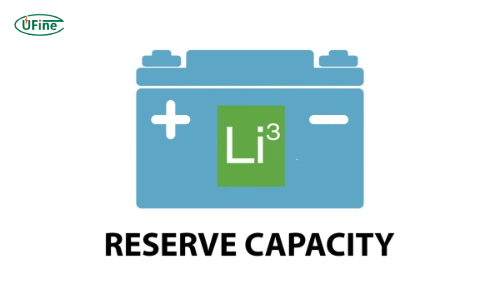
Battery reserve capacity is a crucial feature of batteries that many people need to understand. It tells us how long a battery can provide power when its primary source fails. This article will explain battery reserve capacity, how it is measured, and why it is essential. We will also compare it to amp-hours and help you choose the correct battery.
Part 1. What is battery reserve capacity?
Battery reserve capacity (RC) measures how long a battery can provide power without recharging. It tells us the number of minutes a fully charged battery can deliver a constant 25 amps before the voltage drops below 10.5 volts, usually from 90 to 200 minutes. This is important because it shows the battery’s ability to power devices when the primary power source fails. RC is crucial for battery performance, especially in cars and boats, where reliable power is needed. Understanding RC helps you choose the correct battery to keep your devices running when needed.
Part 2. How battery reserve capacity is measured?
Standard Testing Procedures
- Initial Charge: Fully charge the battery to its maximum capacity.
- Constant Load Application: Apply a continuous load of 25 amps to the battery.
- Voltage Monitoring: Continuously monitor the battery’s voltage during the test.
- Cutoff Voltage: Record when the battery’s voltage drops below 10.5 volts.
- Reserve Capacity Calculation: The time recorded is the battery’s reserve capacity, measured in minutes.
- Controlled Environment: Conduct the test in a controlled environment to ensure accurate results.
Factors Affecting Reserve Capacity
- Temperature: Higher temperatures can increase reserve capacity, while lower temperatures decrease it.
- Age: Older batteries tend to have lower reserve capacities due to wear and tear.
- Discharge Rate: A higher discharge rate can reduce the reserve capacity.
- Maintenance: Proper maintenance can help maintain the battery’s reserve capacity over time.
- Battery Type: Different types of batteries (e.g., lead-acid, lithium-ion) have varying reserve capacities.
- Usage Patterns: Frequent deep discharges can lower reserve capacity, while shallow discharges can help maintain it.
Part 3. Battery reserve capacity vs. amp-hours
What are Amp-Hours?
Amp-hours (Ah) measure a battery’s capacity to deliver a specific current over a certain period. It indicates how much charge a battery can hold and deliver. For example, a battery with a 50 Ah rating can supply a continuous current of 1 amp for 50 hours or 50 amps for 1 hour. Amp-hours are crucial for understanding a battery’s overall capacity and runtime, especially in applications where sustained power delivery is essential, such as renewable energy systems, RVs, and marine vessels.
Comparison Between Reserve Capacity and Amp-Hour Rating
Measurement:
Reserve capacity (RC) measures the number of minutes a battery can sustain a 25-amp load before the voltage drops below 10.5 volts, whereas amp-hour (Ah) rating indicates the total energy a battery can deliver over time.
Load Dependency:
RC is measured at a specific constant load (25 amps), while the Ah rating can vary based on the current draw.
Applications:
RC is essential in automotive applications, where it determines a battery’s ability to start an engine and provide emergency power. On the other hand, the Ah rating is more relevant for devices and systems requiring continuous power delivery over more extended periods, such as solar energy storage systems and electric vehicles.
Performance:
RC measures a battery’s ability to handle high-current situations, such as engine starting, requiring a sudden power surge. Higher RC values indicate better performance in these scenarios. On the other hand, Ah rating indicates a battery’s overall capacity to deliver energy over time, regardless of the load.
Selection:
Choosing the correct battery depends on the specific requirements of the application. RC is more important for applications where sudden bursts of power are critical, such as automotive and marine use. Ah rating is crucial for applications requiring sustained power delivery over extended periods, such as backup power systems and off-grid installations.
Part 4. Importance of reserve capacity in battery selection
- Reliability: Reserve capacity indicates how long a battery can provide power during emergencies, ensuring reliable performance when needed most.
- Starting Power: In automotive applications, reserve capacity determines a battery’s ability to start the engine, which is crucial for vehicle operation.
- Backup Power: For off-grid and backup power systems, reserve capacity ensures continuous operation during power outages, maintaining essential services.
- Marine Use: Reserve capacity is essential for marine vessels, ensuring reliable starting and powering onboard electronics for safety and navigation.
Part 5. How do you determine the correct battery reserve capacity for your needs?
- Calculate Power Needs: Determine your devices’ or systems’ total power requirements to estimate reserve capacity.
- Consider Usage Patterns: You must assess how often and how long you will use the battery to ensure it meets your needs.
- Evaluate Load Requirements: Consider the maximum load your devices require to ensure the battery can handle peak demand.
- Consult Manufacturer Recommendations: Check the manufacturer’s specifications and recommendations to select a battery with adequate reserve capacity for your application.
- Factor in Environmental Conditions: Consider temperature extremes and other environmental factors affecting battery performance and adjust reserve capacity accordingly.
Part 6. FAQs
-
What is a good battery reserve capacity?
A good battery reserve capacity can sustain a load for an extended period without dropping below a certain voltage threshold, typically 10.5 volts. Higher reserve capacity values indicate better performance and reliability in emergencies. -
What does 120 reserve capacity mean on a battery?
A reserve capacity of 120 means the battery can sustain a 25-amp load for 120 minutes before the voltage drops below 10.5 volts. This indicates high performance and reliability, which is suitable for applications requiring prolonged power backup. -
What does poor reserve capacity mean on a battery?
Poor reserve capacity on a battery suggests it cannot adequately sustain a load before the voltage drops below the specified threshold. This indicates diminished performance and reliability, potentially leading to engine starting problems or insufficient backup power. -
Can you restore battery capacity?
You can restore battery capacity through reconditioning or desulfation. These methods involve removing sulfate buildup from the battery plates and restoring electrolyte levels to improve performance. However, the success of these techniques depends on the extent of battery degradation and the type of battery. -
What kills battery capacity?
Several factors can contribute to the decline in battery capacity, including sulfation (the buildup of sulfate crystals on the battery plates), overcharging, deep discharges, high temperatures, and age. These factors can degrade the battery’s internal components and reduce its ability to hold and deliver charge effectively over time.
Related Tags:
More Articles

Battery Load Test: A Comprehensive Guide
Step-by-step battery load test guide for car, solar & industrial use. Learn how to load test a battery, interpret voltage charts, and avoid common mistakes.
The Comprehensive Guide to Battery Balancing and Battery Balancer
Discover how battery balancers improve lithium battery performance, lifespan, and safety. Learn types, functions, and tips to choose the right balancer.
What Is the Best Voltage for a Chainsaw Battery?
Compare 12V-80V chainsaw batteries for light pruning, medium firewood, and professional cutting. See best battery chainsaw with runtime charts and safety tips.
Lithium VS. Alkaline Batteries: A Comprehensive Comparison
Lithium batteries last 3–7× longer than alkaline and perform better in cold weather. Compare lifespan, cost, safety, and best uses to choose the right battery.
Comparing Lithium-Sulfur and Lithium-Ion Batteries: Which is Right for You?
Compare lithium-sulfur (Li-S) and lithium-ion batteries on energy, lifespan, cost, safety, and applications. Best choice for drones, EVs, and electronics.



